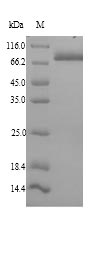The recombinant endoplasmic reticulum chaperone BiP (Hspa5) was produced as a fusion protein with an N-terminal 6xHis tag in the yeast cells. The encoding sequence contains 20-655aa of mouse Hspa5 protein. The purity of this full-length of mature Hspa5 protein reached up to 90% determined by SDS-PAGE. It migrated to a molecular mass band of 78-90 kDa on the gel. The slightly higher result is attributed to glycosylation. This recombinant Hspa5 protein can induce immune reactions in the immunized animals to thus get specific antibodies. Besides, it also may find uses in the tags and cell markers research area.
Heat shock protein family A member 5 (Hspa5), also known as GRP78 or Bip, is a member of heat shock proteins (HSPs) that are involved in proper protein folding, assembly of multiprotein complexes, as well as protein transport and degradation. In response to the accumulation of misfolded proteins in the ER, endoplasmic chaperone protein Hspa5 dissociates from ATF6-IRE1-PERK complex and then translocates into the lumen of the ER. This process unlocks the activity of the signal transducers previously blocked, which leads to the activation of the UPR signaling pathways. Recently, surface HSPA5 has been reported to be a potential receptor of some viruses, including the novel SARS-CoV-2.






